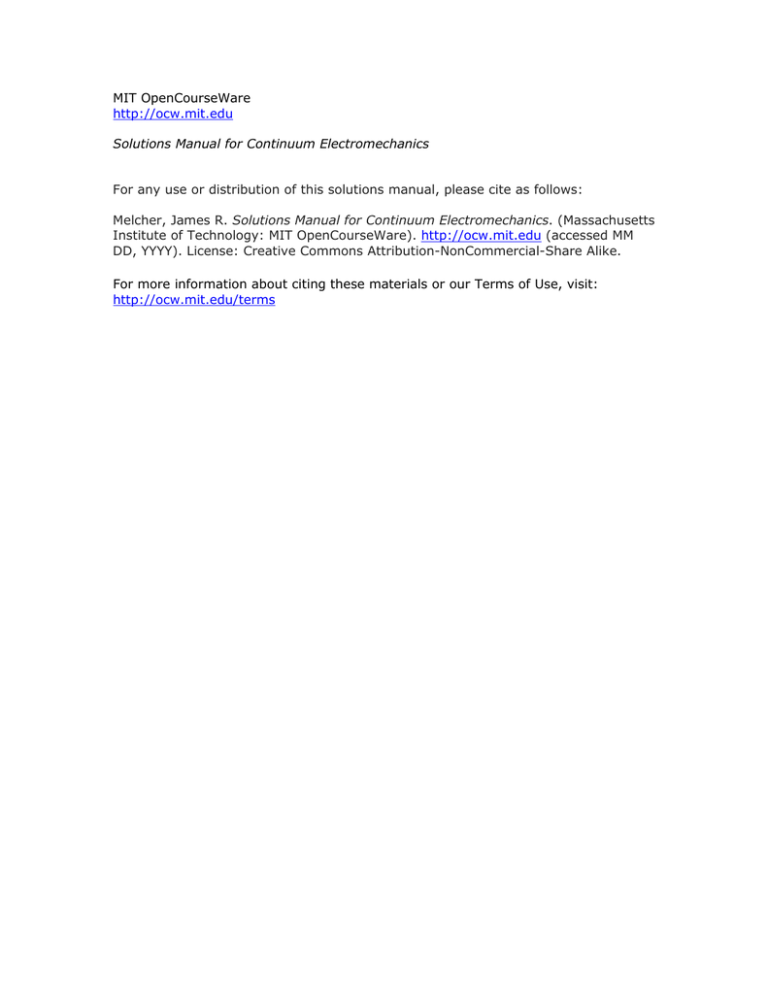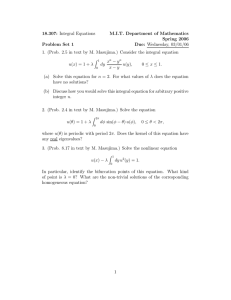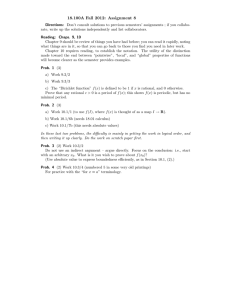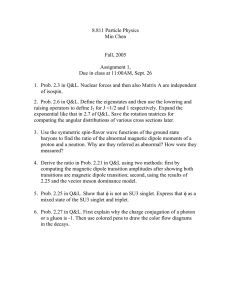MIT OpenCourseWare Solutions Manual for Continuum Electromechanics
advertisement

MIT OpenCourseWare http://ocw.mit.edu Solutions Manual for Continuum Electromechanics For any use or distribution of this solutions manual, please cite as follows: Melcher, James R. Solutions Manual for Continuum Electromechanics. (Massachusetts Institute of Technology: MIT OpenCourseWare). http://ocw.mit.edu (accessed MM DD, YYYY). License: Creative Commons Attribution-NonCommercial-Share Alike. For more information about citing these materials or our Terms of Use, visit: http://ocw.mit.edu/terms 3 Electromagnetic Forces, Force Densitie and Stress Tensors ~K2 /a. i e e1 3.1 With inertia included but H=0, Eqs. 3 become Prob. 3.3.1 - ,_ 0 41+_ (1) M_ |rL = With an imposed RE ei qip + =" equations takes the form t , the response to these linear 4t _e eP . Substitution into Eqs. 1 gives E t (2) £ "n+(-Qr -'-) Thus, for the effect of inertia to be ignorable (3) > cJ +»÷ In terms of the mobility b+= /Mnt. it/ 64 t=n >I'> , Eq. I 3 requires that ,j T 5 For copper, evaluation gives (i.7eXIo")(2 rr)(3x Io 5 ) = 1.34-x 1o I, > (5) At this frequency the wavelength of an electromagnetic wave is = c/4 =3xio/9.14 x)I' Prob. 3.5.1 (a) , which is approaching the optical range(3Z,/2 The cross-derivative of Eq. 9 gives the reciprocity 1). I g condition from which it follows that C12 = C21 (b) The coenergy found in Prob. 2.13.1 can be used with Eq. 3.5.9 to find the two forces. 3 I I 3.2 Prob. 3.5.1 (cont.) IýCl 5 1 (2) _C)1, IL TI · )C (3) _ The specific dependences of these capacitances on the displacements are determined in Prob. 2.11.1. Thus, Eqs. 2 and 3 become (b - ,) Prob. 3.5.2 (a) 2 2 2 , where The system is electrically linear, so w' = ] Cv C is the charge per unit voltage on the positive electrode. throughout the region between the electrodes, E=v/d. I W'---W Cc (b) Note that Hence, +P The force due to polarization tending to pull the slab into the region between the electrodes is then W£ 2. (2) The quantity multiplying the cross-sectional area of the slab, wd, can alternatively be thought'of as a pressure associated with the Kelvin on dipoles induced in the fringing field acting over the force density 5 cross-section (Sec. 3.6) or as the result of the Korteweg-Helmholtz force density (Sec. 3.7). I The latter is confined to a surface force density acting over the cross-section dw, at the dielectric-free space interface. Prob. 3.5.3 I Either viewpoint gives the same net force. From Eq. 9 and the coenergy determined in Prob. 2.13.2, 3.3 Prob. 3.5.4 (a) Using the coenergy function found in Prob. 2.14.1, the radial surface force density follows as _W' (b) = C, (1) 9?. A similar calculation using the X's as the r) independent variables first requires that w(X1 , X2 , be found, and this requires the inversion of the inductance matrix terminal relations, as illustrated in Prob. 2.14.1. i Then, because the Tdependence of w is more complicated than of w', the resulting expression is more cumbersome I to evaluate. ; a 0 However, if it is one of the z !L3 (2) X's that is contrained, this approach is perhaps worthwhile. (c) Evaluation of Eq. 2 with X2 = 0 gives the surface force density if the inner ring completely excludes the flux. z z (3) Z Note that according to either Eq. 1 or 3, the inner coil is compressed, as would be expected by simply evaluating Jf x po H. i To see this from Eq. 1, note that if X =0, then il=-i 2 2. Prob. 3.6.1 Force equilibrium for each element of the static fluid j is where the force density due to gravity could be included, but would not contribute to the discussion. Integration of Eq. (1) from the outside I interface (a) to the lower edge of the slab (b)(which is presumed well within the electrodes)can be carried out without regard for the details I 3.4 Prob. 3.6.1 (cont.) of the field by using Eq. 2.6.1. I = JVt.-(E-.-E~4 (2) Thus, the pressure acting upward on the lower extremity of the slab is (3) L i which gives a force in agreement with the result of Prob. 3.5.2, found using the lumped parameter energy method. 3= 3 d ( w dpb -. (4) ) t With the charges comprising the dipole respectively at r+ and r_, Prob. 3.6.2 the torque is Expanding about the position of the negative charge, r * I- t (Z)rI--V _ a) Ali -- i Iif (2) To first order in d this becomes the desired expression. The torque on a magnetic dipole could be found by using an energy argument 5 replaced by torques and angles. 13 Forces and displacements would be for a discrete system, as in Sec. 3.5. However, because of the complete analogy " S-E and summarized by Eqs. 8-10, I• "b/doM This means that 84-s/Uo and so the desired expression follows directly from Eq. 2. Demonstrate that for a constitutive law implying no inter­ Prob. 3.7.1 action the Korteweg-Helmholtz force density ( +vp.v~ +c IF= becomes the Kelvin force density. Q = and evaluate W ( It O 4w That is, ( -E ) ~. )=0.Let )C (1) = ) _D (2) Thus, -- I C ~ a Z'Xe S" CO (3) Prob. 3.7.1 (cont.) so that -_ý_ww ýp14 w and +· zE, z·D + _ EB L- E ZProb. 3.9.1 ~c E In the expression for the torque, Eq. 3.9.16, i= so that it + YCEo E %L" becomes -- = i Because (IF,-' F,) -t ;c(v s-xi) F= aT 1,, ZýTz) V3T -3 V ±5 (~T, F)IJV( 2) / xi -7i = L 5-(C _ XSj __. T32 ­ +rThý-,t 71,• ) Ia KTLj i2 TIS X -7 T3 z_~c. 3X3 %.T-•S "-rj/l" 3.6 Prob. 3.9.1 (cont.) Because -- =-Ts (symmetry) I x7i7J'+ (cui-aT;)jV (t4)( V From the tensor form of Gauss' theorem, Eq. 3.8.4, this volume integral becomes the surface integral - S / - 11 Prob. 3.10.1 I61 5 Using the product rule, 6t -t) (1) The first term takes the form VlTwhile the second agrees with Eq. 3.7.22 if In index notation, I i L (2) where Eis a spatially varying function. F Because V (3) tO, p Because E--•o required form Prob. 3.10.2 / x £ -~ last term is absent. (4) -e The first term takes the . From Eqs. 2.13.11 and 3.7.19, Thus,3 theWDI Thus, ,the E i~· the force density is _ a- +clEi~)SE -~ (iEb/~xi =r-e/Xz3 E4·; T ari~/~g -o (1) ) ,6' ýW = -t Ž !D- (2) The Kelvin stress tensor, Eq. 3.6.5, differs from Eq. lb only by the term in so the force densities can only differ by the gradient of a pressure. Si 3.7 I Prob. 3.10.3 (a) The magnetic field is "trapped" in the region between tubes. For an infinitely long pair of coaxial conductors, the field in the annulus is uniform. I 2 Hence, because the total flux fa Bo must be constant over the length of the system, in the lower region a2B B o z 2 a (1) 2 -b (b) The distribution of surface current is as sketched below. It is determined by the condition that the magnetic flux at the extremities be as found in (a) and by the condition that the normal flux density on any of the perfectly conducting surfaces vanish. (c) Using the surface force density K x <B>, it is / / / reasonable to expect the net magnetic force in the / z direction to be downward. (d) I One way to find the net force is to enclose the "blob" by the control volume shown in the figure and -1 integrate the stress tensor over the enclosing surface. f z 3 T .n.da ( zi 3i 1 s Contributions to this integration over surfaces (4) and (2) (the walls of the inner and outer tubes which are , . I g 'I . I L 1 perfectly conducting) vanish because there is no shear stress on a perfectly conducting surface. and hence sustains no magnetic stress. 3' II I` I I I I I ·1 I Surface (5) cuts under the "b]ob" Hence, only surfaces (1) and (3) make I contributions, and on them the magnetic flux density is given and uniforn Hence, the net force is (2) Note that, as expected, this force is negative. IE I I figure. 'p---- - - - - ­ The electric field is sketched in the Prob. 3.10.4 The force on the cap should be upward. To \S find this force use the surface S shown to enclose the cap. On S1 the field is zero. IF I On S2 and S3 the I I electric shear stress is zero because it is an equi­ I I I1 I I I' potential and hence can support no tangential E. S the field is zero. Finally, on S 5 the field is that of infinite coaxial conductors. V0 II k't t! I I _ I..J I I I I I I l·_, II I 4 I I I I I -I • Thus, the normal electric stress is reduces to total the force for integral the and - and the integral for the total force reduces to )Z V='60Z* i + I • -I;=L: 4 4 -V.6 E.( 3 ) ' S Prob. 3.10.5 Because a• hi 2-dWCA I·z f,=~T~ h. I I I On . Ž the last term becomes Thus IF 1 e a E z,'F- GOELS i where the quantity in brackets is T... 13 Because T.. is the same as any -3 of the T..'s in Table 3.10.1 when evaluated in free space, use of a surface S surrounding the object to evaluate Eq. 3.9.4 will give a total force in agreement with that predicted by the correct force densities. 3.9 I Prob. 3.10.6 I Showing that the identity holds is a matter of simply writing out the components in cartesian coordinates. The i'th component of the force density is then written using the identity to write JxB where J = VxH. In the first term, B. is moved inside the derivative and the condition / X• ='&'.' O exploited. The third term is replaced by the magnetic analogue of Eq. 3.7.26. -ý -<J (2) The second and third terms cancel, so that this expression can be rewritten Fi(W +• -- .- -W la=" . (3) 9 and the stress tensor identified as the quantity in brackets. Problem 3.10.7 The i'th component of the force density is written using the identity of Prob. 2.10.5 to express Jf x po H = (VxH) x VoH = I (1) o0 This expression becomes where the first two terms result from the first term in F., the third term results from taking the H. inside the derivative and the last two terms are an expansion of the last term in F.. combine to give V/•t. ( 9 * )-V. The second and last term = O Thus, with B =••(A+A) expression takes the proper form for identifying the stress tensor. ~Fi d)U; -F r I, (~j~C , the I I 3.10 Prob. 3.10.8 The integration of the force density over the volume of I the dielectric is broken into two parts, one over the part that is well i between the plates and therefore subject to a uniform field v/b, and the other enclosing what remains to the left. Observe that throughout this latter volume, the force density acting in the V direction is zero. That is, the force density is confined to the interfaces, where it is singular and constitutes a surface force density acting normal to the interfaces. i The only region where the force density acts in the T direction is on the interface at the right. 5 volume integration can be replaced by an integration of the stress over the enclosing surface. I CI This is covered by the first integral, and the . Thus, CL (1) in agreement with the result of Prob. 2.13.2 found using the energy method. Prob. 3.11.1 With the substitution V =- 'h (suppress the subscript E), Eq. 1 becomes where the first two terms on the right come from expanding V.4AY"T'7Ithe first two terms in the integrand of Eq. 4 are accounted for. Thus, To see that the last term in the integrand on the right in Eq. 1 accounts for remaining term in Eq. (4) of the problem, this term is written out in Cartesian coordinates. 'In IMI K + S(2) i ­ I 3.11 Prob. 3.11.1 (cont.) Further expansion gives +L , S 1 x + (3) a.. h4 6 I' + Note that n 2 + n 2 + x y = 1. z Thus, the first third and fifth terms become The second term can be written as The fourth and sixth terms are similarly zero. vanish and Eq. 3 is simply 6 . Thus, these three terms Thus, Eq. 1 becomes +(5) With the given alternative ways to write these terms, it follows that Eq. 5 is consistent with the last two terms of Eq. 3.11.8. Prob. 3.11.2 Use can be made of Eq. 4 from Prob. 3.11.1 to convert the integral over the surface to one over a contour C enclosing the surface. If the surface, S, is closed,then the contourC,must vanish and it is clear that the net contribution of the integration is zero. not produce a net force on a closed surface. The double-layer can







